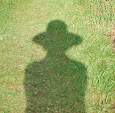This tree lead Iain and I to see if it still exsisted in the grounds of Castle Menzies in central Scotland. Yes, it is still there. It is an Arbutus, a lovely tree with characteristic red bark, very common on the west coast of British Columbia.
Why is it here? There are (at least?) two reasons. It seems that "in the nineteenth century Sir Neil Menzies of Menzies, 6th Baronet, actively promoted tree planting and agricultural improvements which were continued by his son Sir Robert." That would make sense. It is probably about 150 years old and is mentioned in the book The Scots Trees in the side bar on the right. (Unfortunately that particular book is presently in storage so I can't get the full story about it.)
Why is it here? There are (at least?) two reasons. It seems that "in the nineteenth century Sir Neil Menzies of Menzies, 6th Baronet, actively promoted tree planting and agricultural improvements which were continued by his son Sir Robert." That would make sense. It is probably about 150 years old and is mentioned in the book The Scots Trees in the side bar on the right. (Unfortunately that particular book is presently in storage so I can't get the full story about it.)
 "Arbutus is the only native broadleaf evergreen tree in Canada. Another common name is madrone, a Spanish word for the strawberry tree, of which arbutus is a close relative. " (See also here for Pacific madrone tree description.)
"Arbutus is the only native broadleaf evergreen tree in Canada. Another common name is madrone, a Spanish word for the strawberry tree, of which arbutus is a close relative. " (See also here for Pacific madrone tree description.)And upon looking it up on Google it is ... Arbutus menziesii. This is because "the Scottish botanist Archibald Menzies here first collected specimens in 1792 and described it as the oriental strawberry tree." (Taken from website here where there are full details about the plant and its habitat.)
Menzies was Captain George Vancouver's botanist on board HMS Discovery. Menzies noted the species during Vancouver's voyage of exploration on the west coast of B.C. Ultimately, his specimens were taken to Kew. I must find out if it is known how this surviving speciman got established at Castle Menzies.
 The flowers are out just now - see right foreground - and that is Castle Menzies is in the background.
The flowers are out just now - see right foreground - and that is Castle Menzies is in the background. Bluebells are out everywhere! The banks along the road, the woodlands are plastered in bluebells! Carpets of purple! Here is a small bunch at the entrance of Castle Menzies.
Bluebells are out everywhere! The banks along the road, the woodlands are plastered in bluebells! Carpets of purple! Here is a small bunch at the entrance of Castle Menzies. And on the wall at right angles to the castle entrance is this intriguing door covered by a grill and a plaque above. I can find absolutely no information on the plaque. I am therefore wondering if the letters IMBS refer to people's initials I (or J in Latin) M (?Menzies) and maybe the name of a bride? The only reason I put this forward is that I recall in Kings College Chapel, Cambridge, the initials of Henry VIII and Anne Boleyn were carved in a (large!) wooden screen mid-chapel. The date of that work was 1533-1536 (reference here) and the date below this plaque is 1571 so the period might indicate a particular style or convention of the age. Also I notice a similarity in what I think might be the lovers knots' artwork in the two examples.
And on the wall at right angles to the castle entrance is this intriguing door covered by a grill and a plaque above. I can find absolutely no information on the plaque. I am therefore wondering if the letters IMBS refer to people's initials I (or J in Latin) M (?Menzies) and maybe the name of a bride? The only reason I put this forward is that I recall in Kings College Chapel, Cambridge, the initials of Henry VIII and Anne Boleyn were carved in a (large!) wooden screen mid-chapel. The date of that work was 1533-1536 (reference here) and the date below this plaque is 1571 so the period might indicate a particular style or convention of the age. Also I notice a similarity in what I think might be the lovers knots' artwork in the two examples.Later: John has found the answer here. IM= James Menzies and BS= Barbara Stuart and the date is when they got married.




No comments:
Post a Comment